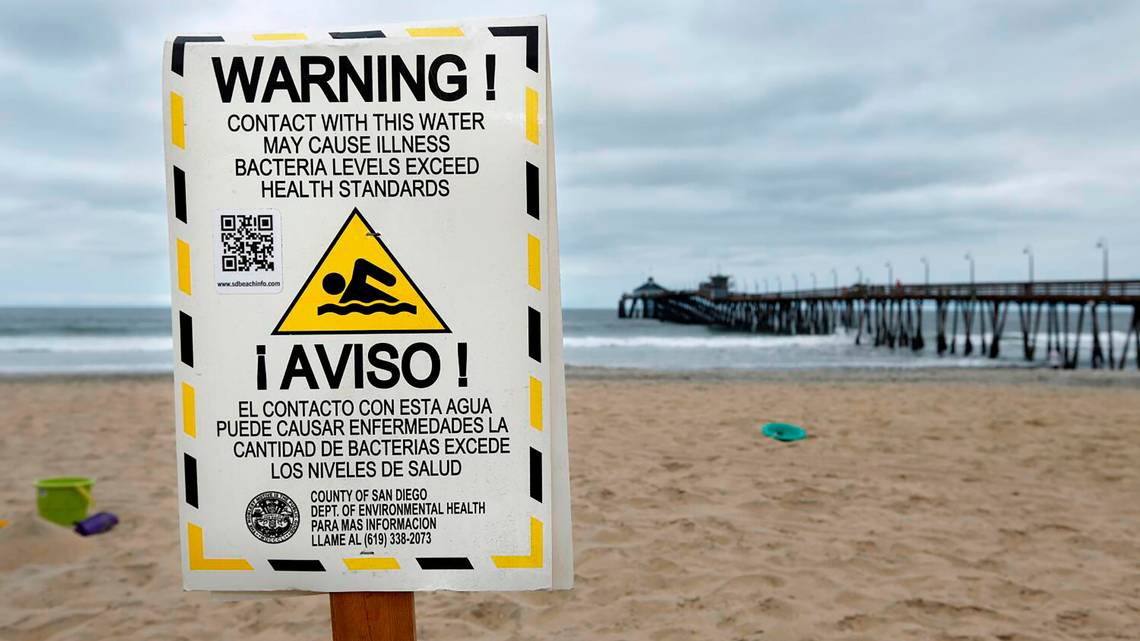Signs warn beachgoers in San Diego’s Imperial Beach of high bacteria levels in the water, which is often due to sewage from Tijuana. (K.C. Alfred/San Diego Union -Tribune/TNS)
TNS
SAN DIEGO – San Diego County is officially calling on state and federal public health agencies to investigate the effects of cross-border pollution on the region.
Dr. Wilma Wooten, the county’s public health director, submitted a “public health request” to the U.S. Centers for Disease Control and Prevention (CDC) and the California Department of Public Health (CDPH) on Tuesday.
The move was taken at the direction of county Chairperson Nora Vargas, whose District 1 includes the communities directly affected by sewage and toxic chemicals from Tijuana. Vargas sent her own letter to CDC Director Mandy Cohen underscoring what she wanted the public agency to do.
“Specifically, I urge the CDC to examine the prevalence of contaminants in the air, water and soil of these communities and their connection to community-reported increases in gastrointestinal issues and other symptoms,” Vargas said in the letter.
State and federal agencies did not respond to requests for comment.
The request marks an important step in getting the CDC to step in. Calls from Imperial Beach Mayor Paloma Aguirre and several San Diego area members of Congress asking the national public health agency to look into the festering situation at the border have been turned aside.
The CDC said for the agency to offer epidemiological assistance, or Epi-Aid, it must first be invited by local public health authorities in coordination with state authorities.
Such a request would enable “rapid, short-term (1–3 weeks), generally onsite, technical assistance by (Epidemic Intelligence Service) officers and other CDC subject matter experts,” its website says. “The focus of an Epi-Aid investigation is to assist partners in making rapid, practical decisions for actions to control and prevent the public health problem.”
Until now, the county had limited its intervention to surveillance because it had not seen any increases in reported infections expected from exposure to polluted water. However, not all infections are required to be reported to the public health system.
San Diego researchers and physicians believe a non-traditional approach is necessary to better understand the issue given that no private or public investigations have been done. They recently formed a task force to understand if there are any links between the symptoms people are feeling and water and air contamination.
Aguirre, who is leading the task force, said in a statement that she was “happy to receive this level of commitment from the county.”
“The people of South Bay have been suffering appalling conditions for the better part of the last two years,” she added. “We hope the CDC, CDPH and the Office of the Governor give this emergency the serious level of attention it merits.”
People who live and work in South County’s southernmost communities such as Imperial Beach, Nestor, San Ysidro and the Tijuana River Valley, have reported headaches, chronic coughs, diarrhea, vomiting and other symptoms, particularly after heavy rains when more sewage hits the riverbed and when odors seem stronger during hotter and drier days.
Local physicians have found correlations between sewage pollution and gastrointestinal and respiratory issues. And public and environmental health researchers have cited broad evidence that water and air contamination endangers the health of those exposed.
A recent San Diego State University report highlighted the presence of banned pesticides and drug-resistant bacteria in the Tijuana River, and that contaminated air from the region could potentially harm people’s health without any direct contact with polluted waters.
Years of disrepair and underinvestment in treatment plants on both sides of the U.S.-Mexico border have led to billions of gallons of partially treated wastewater contaminating Tijuana and south San Diego County communities. The International Boundary and Water Commission, responsible for operating the aging South Bay plant, had historically been hampered by several funding limitations, making maintenance challenging for an agency that oversees numerous projects along the border.
The IBWC said a recent increase to its annual budget will allow it to make repairs and bring relief to affected communities more quickly.
Officials continue to urge Gov. Gavin Newsom and President Joe Biden to declare the cross-border pollution an emergency to expedite access to federal resources and additional funding.
_______
Copyright 2024 Tribune Content Agency. All Rights Reserved.
This story was originally published May 22, 2024, 10:42 PM.
